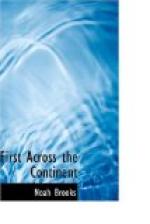Nor was the Pacific shore of the country any better known to civilized man than was the region lying between that coast and the Big Muddy, or Missouri River. Spanish voyagers, in 1602, had sailed as far north as the harbors of San Diego and Monterey, in what is now California; and other explorers, of the same nationality, in 1775, extended their discoveries as far north as the fifty-eighth degree of latitude. Famous Captain Cook, the great navigator of the Pacific seas, in 1778, reached and entered Nootka Sound, and, leaving numerous harbors and bays unexplored, he pressed on and visited the shores of Alaska, then called Unalaska, and traced the coast as far north as Icy Cape. Cold weather drove him westward across the Pacific, and he spent the next winter at Owyhee, where, in February of the following year, he was killed by the natives.
All these explorers were looking for chances for fur-trading, which was at that time the chief industry of the Pacific coast. Curiously enough, they all passed by the mouth of the Columbia without observing that there was the entrance to one of the finest rivers on the American continent.
Indeed, Captain Vancouver, a British explorer, who has left his name on the most important island of the North Pacific coast, baffled by the deceptive appearances of the two capes that guard the way to a noble stream (Cape Disappointment and Cape Deception), passed them without a thought. But Captain Gray, sailing the good ship “Columbia,” of Boston, who coasted those shores for more than two years, fully convinced that a strong current which he observed off those capes came from a river, made a determined effort; and on the 11th of May, 1792, he discovered and entered the great river that now bears the name of his ship. At last the key that was to open the mountain fastnesses of the heart of the continent had been found. The names of the capes christened by Vancouver and re-christened by Captain Gray have disappeared from our maps, but in the words of one of the numerous editors(1) of the narrative of the exploring expedition of Lewis and Clark: “The name of the good ship ‘Columbia,’ it is not hard to believe, will flow with the waters of the bold river as long as grass grows or water runs in the valleys of the Rocky Mountains.”
(1) Dr. Archibald McVickar.
It appears that the attention of President Jefferson had been early attracted to the vast, unexplored domain which his wise foresight was finally to add to the territory of the United States. While he was living in Paris, as the representative of the United States, in 1785-89, he made the acquaintance of John Ledyard, of Connecticut, the well-known explorer, who had then in mind a scheme for the establishment of a fur-trading post on the western coast of America. Mr. Jefferson proposed to Ledyard that the most feasible route to the coveted fur-bearing lands would be through the Russian possessions and downward somewhere near




